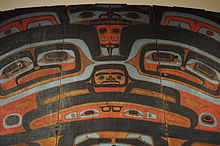
Formline art is a feature in the Indigenous art of the Northwest Coast of North America, distinguished by the use of characteristic shapes referred to as ovoids, U forms and S forms. Coined by Bill Holm in his 1965 book Northwest Coast Indian Art: An Analysis of Form,[1][2] the "formline is the primary design element on which Northwest Coast art depends, and by the turn of the 20th century, its use spread to the southern regions as well. It is the positive delineating force of the painting, relief and engraving. Formlines are continuous, flowing, curvilinear lines that turn, swell and diminish in a prescribed manner. They are used for figure outlines, internal design elements, and abstract compositions."[3]
- ^ ""Haida Art - Mapping an Ancient Language", musee-mccord.qc.ca. Retrieved Nov. 22, 2011". Archived from the original on 2014-05-13. Retrieved 2011-11-22.
- ^ ""Bill Holm: Northwest Coast Indian Art", washington.edu. Retrieved Nov. 22, 2011". Archived from the original on 2011-04-25. Retrieved 2011-11-22.
- ^ Marjorie M. Halpin (March 4, 2015). "Northwest Coast Indigenous Art". The Canadian Encyclopedia. Historica Canada. Retrieved August 19, 2019.
